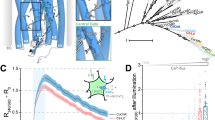Abstract
Chick pineal cells maintained in dissociated cell culture express an intrinsic photosensitive circadian oscillator, but the mechanisms of phototransduction in avian pinealocytes are not fully understood. In this study, we have used inside-out patches to examine the characteristics of cyclic GMP-activated channels of chick pinealocytes in more detail, concentrating on the effects of factors known to modulate the secretion of melatonin and/or the function of circadian pacemakers. In most patches, the predominant conductance state was 19 pS in symmetrical 145 mM NaCl. But in some patches, a second cyclic GMP-activated channel with a unitary conductance of 29 pS was also present. The current flowing through cyclic GMP-activated channels was not affected by application of salines containing 1 μM Ca2+ to the cytoplasmic face of the patch membrane. By contrast, application of 1 mM Ca2+ caused a partial reduction in cyclic GMP-activated current at all membrane potentials. Application of 1–5 mM Mg2+ ions caused a virtually complete blockade of current at positive membrane potentials, but caused only a small decrease in current at negative membrane potentials. No obvious differences in the gating of cyclic GMP-activated channels were observed in pH 8.2, 7.4 or 6.2 salines. Application of salines containing 100 μM, 500 μM, or 1 mM cyclic AMP did not cause activation of the channels, but 5 mM cyclic AMP evoked a low level of channel activity. Application of 5 mM but not 100 μM cyclic AMP decreased the probability of channel activation caused by 20–100 μM cyclic GMP and also increased the percentage of openings to an 11 pS subconductance state. Thus, cyclic AMP acts as a weak partial agonist. Nevertheless, the gating of these channels does not seem to be controlled directly by physiologically relevant changes in intracellular Ca2+, pH, or cyclic AMP.
Similar content being viewed by others
References
Altenhofen W, Ludwig J, Eismann E, Kraus W, Bönig KW, Kaupp UB (1991) Control of ligand specificity in cyclic nucleotidegated channels from rod photoreceptors and olfactory epithelium. Proc Natl Acad Sci USA 88:9868–9872
Bischoff MB (1969) Photoreceptoral and secretory structures in the avian pineal organ. J Ultrastruct Res 28:16–26
Collin JP, Oksche A (1981) Structural and functional relationships in the non-mammalian pineal gland. In: Reiter R (ed) The pineal gland, vol. 1. CRC Press, Boca Raton, FL pp 27–67
Collin JP, Mirshashi M, Brisson P, Falcon J, Guerlotte J (1986) Pineal retinal molecular relationships: distribution of “Santigen” in the pineal complex. Neuroscience 19:657–666
Deguchi T (1979a) A circadian oscillator in cultured cells of the chicken pineal gland. Nature 282:94–96
Deguchi T (1979b) Role of adenosine 3′,5′-monophosphate in the regulation of circadian oscillation of serotonin-N-acetyltransferase activity in chicken pineal gland. J Neurochem 33:45–51
Deguchi T (1981) Rhodopsin-like sensitivity of isolated chicken pineal gland. Nature 290:706–707
Dryer SE, Henderson D (1991) A cyclic GMP-activated channel in acutely dissociated cells of the chick pineal gland. Nature 353:756–758
Dryer SE, Dourado MM, Wisgirda ME (1991) Characteristics of multiple Ca2+ activated K+ channels in acutely dissociated cells of the chick ciliary ganglion. J Physiol (Lond) 443:601–627
Foster R, Horf HW, Schalken J (1987) Immunocytochemical markers revealing retinal and pineal but not hypothalamic photoreceptor systems in the Japanese quail. Cell Tissue Res 248:161–169
Furman RE, Tanaka JC (1989) Photoreceptor channel activation: interaction between cAMP and cGMP. Biochemistry 28:2785–2788
Harrison NL, Zatz M (1989) Voltage-dependent Ca2+ channels regulate melatonin output from cultured chick pineal cells. J Neurosci 9:2462–2467
Haynes L, Yau KW (1990) Single-channel measurement from the cyclic GMP-activated conductance of catfish retinal cones. J Physiol (Lond) 429:451–481
Henderson D, Dryer SE (1992) Voltage- and Ca2+-activated ionic currents in acutely dissociated cells of the chick pineal gland. Brain Res 572:182–189
Katz BJ, Oakley B (1990) Evidence for Na+/H+ exchange in vertebrate photoreceptors. Exp Eye Res 49:199–207
Kaupp UB (1991) The cyclic nucleotide-activated channels of vertebrate photoreceptors and olfactory epithelium. Trends Neurosci 14:150–157
Khalsa SB, Ralph M, Block GD (1991) Does low intracellular pH stop the motion of the Bulla circadian pacemaker? J Neurosci 11:2672–2679
Liebman PA, Mueller P, Pugh EN (1984) Protons suppress the dark current of retinal rods. J Physiol (Lond) 347:85–110
Lolley RN, Lee RH (1990) Cyclic GMP and photoreceptor function. FASEB J 4:3001–3008
Martel AE, Smith RM (1974) Critical stability constants. vol 1, Plenum Press, New York p 269
Matthews HR, Murphy RL, Fain GL, Lamb TD (1988) Photoreceptor light adaptation is mediated by cytoplasmic calcium concentration. Nature 334:67–69
Matthews HR, Fain GL, Murphy RL, Lamb TD (1990) Light adaptation in cone photoreceptors of the salamander: A role for cytoplasmic calcium. J Physiol (Lond) 420:447–469
Menini A (1989) The effect of hydrogen ions on the cyclic GMP-activated currents carried by Na+, K+ or Li+ in excised patches from retinal rods of the salamander. J Physiol (Lond) 418:123P
Mirshashi M, Faure JP, Brisson P, Falcon J, Guerlotte J, Collin J (1984) S-antigen in retinal rods and cones and pineal photosensitive cells. Biol Cell 52:195–198
Moolenaar WH (1986) Effects of growth factors on intracellular pH regulation. Annu Rev Physiol 48:363–376
Nakamura T, Gold GH (1987) A cyclic nucleotide-gated conductance in olfactory receptor cilia. Nature 325:442–444
Nakatani K, Yau K-W (1988) Calcium and light adaptation in retinal rods and cones. Nature 334:69–71
Nikaido S, Takahashi JS (1989) Twenty-four hour oscillation of cyclic AMP in the acute and circadian regulation of melatonin production. Neuron 3:609–619
Pu G, Dowling J (1981) Anatomical and physiological characteristics of pineal photoreceptor cells in the larval lamprey, Petromyzon marinus. J Neurophysiol 46:1023–1035
Robertson LM, Takahashi JS (1988a) Circadian clock in cell culture. I. Oscillation of melatonin release from dissociated chick pineal cells in flow-through microcarrier culture. J Neurosci 8:12–21
Robertson LM, Takahashi JS (1988b) Circadian clock in cell culture. II. In vitro photic entrainment of melatonin oscillation from dissociated chick pineal cells. J Neurosci 8:22–31
Takahashi JS, Murakami N, Nikaido S, Pratt B, Robertson LM (1989) The avian pineal, a vertebrate model system of the circadian oscillator: Cellular regulation of circadian rhythms by light, secondary messengers, and macromolecular synthesis. Rec Prog Horm Res 45:279–352
Tamotsu S, Morita Y (1986) Photoreception in pineal organs of larval and adult lampreys, Lampetra japonica. J Comp Physiol A 159:1–15
Van Veen T, Ostholm T, Gierschik P, Spiegel A, Somers R, Korf HW, Klein DC (1986) Alpha-transducin immunoreactivity in retina and sensory pineal organs of adult vertebrates. Proc Natl Acad Sci USA 13:921–916
Vigh B, Vigh-Teichmann I (1982) Light- and electron-microscopic demonstration of immunoreactive opsin in the inealocytes of various vertebrates. Cell Tissue Res 221:451–463
Voisin P, Guerlotte J, Collin JP (1988) An antiserum against chicken hydroxyindole-O-methyltransferase reacts with the enzyme from pineal gland and retina and labels pineal modified photoreceptors. Mol Brain Res 4:53–61
Wainwright S, Wainwright L (1984) Relationship between cycles in level of serotonin N-acetytransferase activity and cyclic GMP content of cultured chick pineal glands. J Neurochem 43:358–363
Wallingford JC, Zatz M (1988) A novel photopigment candidate in membranes of cultured chick pineal cells. Exp Eye Res 46:909–918
Yau KW, Baylor D (1989) Cyclic GMP-activated conductance of retinal photoreceptor cells. Annu Rev Neurosci 12:289–327
Zatz M, Mullen D (1988a) Norepinephrine, acting via adenylate cyclase, inhibits melatonin output but does not phase-shift the pacemaker in cultured chick pineal cells. Brain Res 438:199–215
Zatz M, Mullen D (1988b) Photoendocrine transduction in cultured chick pineal cells (II): effects of forskolin, 8-bromocyclic AMP and 8-bromocyclic GMP on the melatonin rhythm. Brain Res 453:51–62
Zatz M, Mullen D (1988c) Two mechanisms of photoendocrine transduction in cultured chick pineal cells: pertussis toxin blocks the acute but not the phase-shifting effects of light on the melatonin rhythm. Brain Res 453:63–71
Zatz M, Mullen D (1988d) Does calcium influx regulate melatonin production through the circadian pacemaker in chick pineal cells? Effects of nitrendipine, BAY K 8644, Co2+, Mn2+ and low external Ca2+. Brain Res 463:305–316
Zatz M, Wang HM (1991) High salt mimics the effects of light on the circadian pacemaker in cultured chick pineal cells. Am J Physiol 260:R769-R776
Zatz M, Mullen D, Moskal JR (1988) Photoendocrine transduction in cultured chick pineal cells: effects of light, dark, and potassium on the melatonin rhythm. Brain Res 438:199–215
Zawilska JB, Nowak JZ (1990) Calcium influx through voltagesensitive calcium channels regulates in vivo serotonin N-acetyltransferase (NAT) activity in hen retina and pineal gland. Neurosci Lett 118:17–20
Zimmerman AL, Baylor DA (1992) Cation interactions within the cyclic GMP-activated channel of retinal rods from the tiger salamander. J Physiol (Lond) 449:759–783
Zufall F, Firestein S, Shepherd GM (1991a) Analysis of single cyclic nucleotide-gated channels in olfactory receptor cells. J Neurosci 11:3573–3580
Zufall F, Firestein S, Shepherd GM (1991b) Inhibition of the olfactory cyclic nucleotide-gated ion channel by intracellular Ca2+. Proc R Soc Lond B 246:225–230
Author information
Authors and Affiliations
Rights and permissions
About this article
Cite this article
Dryer, S.E., Henderson, D. Cyclic GMP-activated channels of the chick pineal gland: Effects of divalent cations, pH, and cyclic AMP. J Comp Physiol A 172, 271–279 (1993). https://doi.org/10.1007/BF00216609
Accepted:
Issue Date:
DOI: https://doi.org/10.1007/BF00216609




